Blch-Rt-RW
RSP 13198
Grower: Zamir Punja
General Information
- Sample Name
- Blch-Rt-RW-20240801
- Accession Date
- August 7, 2024
- Reported Plant Sex
- Female
- Report Type
- Whole-Genome Sequencing
- Microbiome
- Krona Plot
- Fungal Microbiome
- Krona Plot
- Bacterial Microbiome
- Krona Plot
- Viral Microbiome
- Krona Plot
The strain rarity visualization shows how distant the strain is from the other cultivars in the Kannapedia database. The y-axis represents genetic distance, getting farther as you go up. The width of the visualization at any position along the y-axis shows how many strains there are in the database at that genetic distance. So, a common strain will have a more bottom-heavy shape, while uncommon and rare cultivars will have a visualization that is generally shifted towards the top.
Chemical Information
Cannabinoid and terpenoid information provided by the grower.
Cannabinoids
No information provided.
Terpenoids
No information provided.
Genetic Information
- Plant Type
- Type I
File Downloads
The bell curve in the heterozygosity visualization shows the distribution of heterozygosity levels for cannabis cultivars in the Kannapedia database. The green line shows where this particular strain fits within the distribution. Heterozygosity is associated with heterosis (aka hybrid vigor) but also leads to the production of more variable offspring. When plants have two genetically different parents, heterozygosity levels will be higher than if it has been inbred or backcrossed repeatedly.
The ratio of reads mapped to Y-contigs to reads mapped to the whole Cannabis genome (Y-ratios) has been demonstrated to be strongly correlated with plant sex typing. This plot shows the distribution of Y-ratios for all samples in our database which were sequenced with the same method (panel or WGS) as this sample and where this sample falls in the distribution.
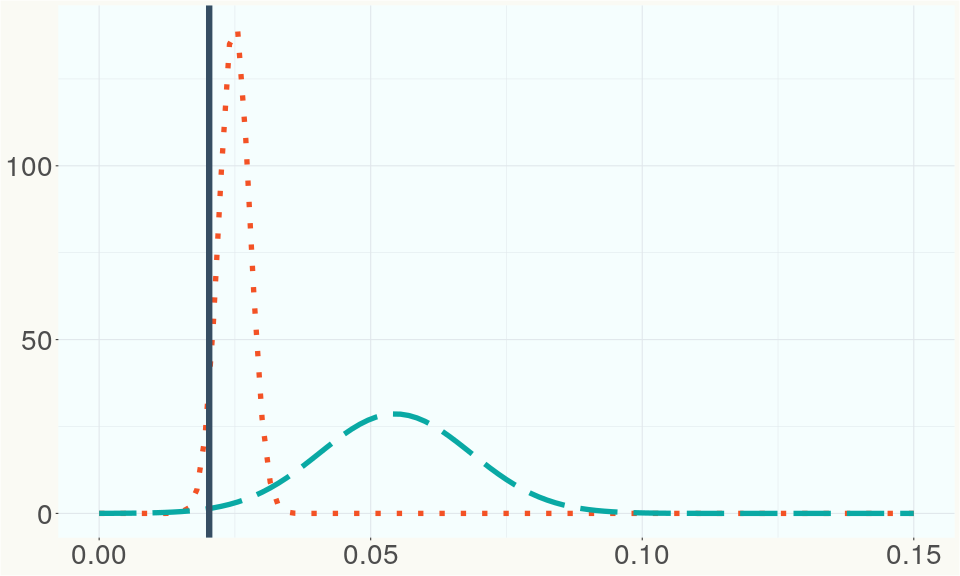
This chart represents the Illumina sequence coverage over the Bt/Bd allele. These are the three regions in the cannabis genome that impact THCA, CBDA, CBGA production. Coverage over the Active CBDAS gene is highly correlated with Type II and Type III plants as described by Etienne de Meijer. Coverage over the THCA gene is highly correlated with Type I and Type II plants but is anti-correlated with Type III plants. Type I plants require coverage over the inactive CBDA loci and no coverage over the Active CBDA gene. Lack of coverage over the Active CBDA and Active THCA allele are presumed to be Type IV plants (CBGA dominant). While deletions of entire THCAS and CBDAS genes are the most common Bt:Bd alleles observed, it is possible to have plants with these genes where functional expression of the enzyme is disrupted by deactivating point mutations (Kojoma et al. 2006).
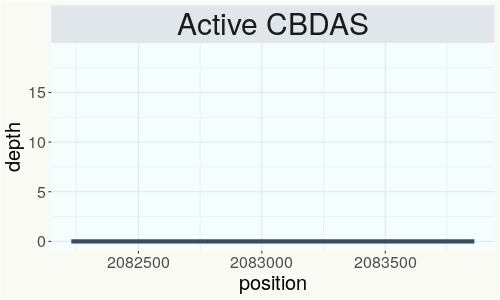
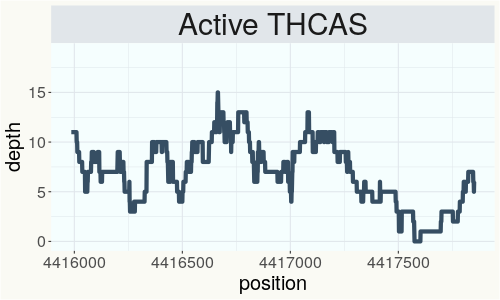
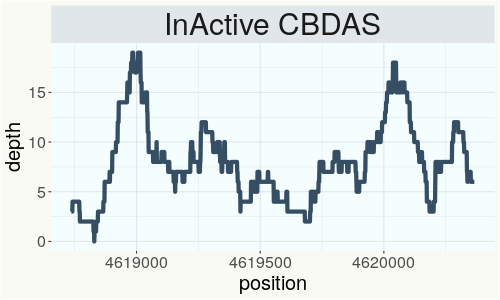
This chart represents the Illumina sequence coverage over the CBCA synthase gene.
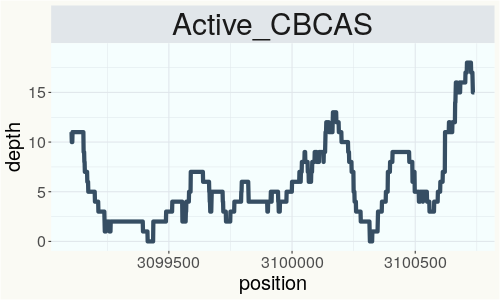
Variants (THCAS, CBDAS, and CBCAS)
Variants (Select Genes of Interest)
| PHL-2 | c.2578T>A | p.Leu860Ile | missense variant | moderate | contig2621 | 342621 | T/A | |
| PHL-2 |
c.2903_2905d |
p.Ser968dup | disruptive inframe insertion | moderate | contig2621 | 342939 | T/TGCA | |
| PHL-1 | c.2623A>G | p.Thr875Ala | missense variant | moderate | contig1439 | 1487174 | T/C |
|
| Edestin | c.241C>T | p.Gln81* | stop gained | high | contig850 | 3065049 | G/A |
|
| HDS-1 | c.136G>A | p.Val46Ile | missense variant | moderate | contig1891 | 889256 | C/T | |
| FLD | c.125G>A | p.Ser42Asn | missense variant | moderate | contig1450 | 2047909 | C/T | |
| PKSB-3 | c.1901C>G | p.Ala634Gly | missense variant | moderate | contig93 | 3340008 | C/G |
|
Nearest genetic relatives (All Samples)
- 0.048 BCP-St-NoMET (RSP13195)
- 0.051 BCP St-Fl (RSP13140)
- 0.053 BCP Buds (RSP13137)
- 0.054 BCP-Lf-NoMET (RSP13191)
- 0.057 BCP-St-MET (RSP13194)
- 0.058 BCP-Rt-NoMET (RSP13193)
- 0.058 BCP-Rt-MET (RSP13192)
- 0.059 BCP Rt-Fl (RSP13138)
- 0.088 BCP Lf-Fl (RSP13139)
- 0.106 BCP Dring (RSP13118)
- 0.110 BCP Lf-MET (RSP13190)
- 0.121 Blch-Rt-Coco (RSP13197)
- 0.151 BCP-Stem-Fl2 (RSP13196)
- 0.202 Blch Buds (RSP13134)
- 0.204 Blch St-Fl (RSP13136)
- 0.205 Blch Rt-Fl (RSP13135)
- 0.207 D1 (RSP12875)
- 0.239 T20G (RSP13091)
- 0.240 T20I (RSP13093)
- 0.240 T20H (RSP13092)
Most genetically distant strains (All Samples)
- 0.461 Cherry Blossom (RSP11317)
- 0.445 Jamaican Lion (RSP12916)
- 0.444 Cherry Blossom (RSP11323)
- 0.443 JL yellow (RSP11075)
- 0.438 JL 3rd Gen Mother (RSP11214)
- 0.438 Cherry Blossom (RSP11311)
- 0.437 Jamaican Lion (RSP12917)
- 0.434 Cherry Blossom (RSP11306)
- 0.432 Cherry Blossom (RSP11314)
- 0.430 Cherry Blossom (RSP11328)
- 0.425 Jamaican Lion (RSP12915)
- 0.423 Cherry Blossom (RSP11325)
- 0.421 Cherry Blossom (RSP11309)
- 0.419 Tiger Tail 30 (RSP11484)
- 0.417 Cherry Blossom (RSP11335)
- 0.416 Cherry Blossom (RSP11330)
- 0.416 Cherry Blossom (RSP11298)
- 0.415 Bialobrzeskie (SRR14708244)
- 0.415 Unknown- Cherry Wine - 003 (RSP11270)
- 0.415 Cherry Blossom (RSP11308)
Nearest genetic relative in Phylos dataset
- Overlapping SNPs:
- 88
- Concordance:
- 56
Nearest genetic relative in Lynch dataset
- Overlapping SNPs:
- 10
- Concordance:
- 8
Blockchain Registration Information
- Transaction ID
-
RSP13198-mgc-ots
-certificate - Stamping Certificate
- Download PDF (1.2 MB)
- SHASUM Hash
-
218fa1b1451d88496539bd99578eed3b 5d6f6efdbd71ec34 c853ba4beb8131aa